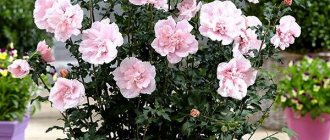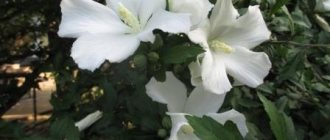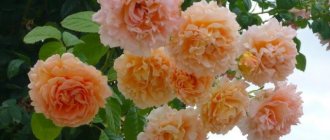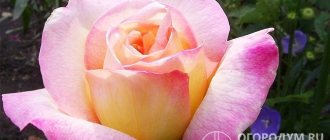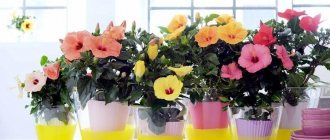Syrian hibiscus is a frost-resistant perennial plant. It can be grown in regions where the air temperature in winter drops to -20°C, but for this, garden hibiscus needs to create comfortable conditions:
- choose the right landing site;
- regularly carry out formative pruning and fertilizing;
- mulch the soil near the bush in the autumn.
In the southern regions, where the air temperature does not drop below -15°C in winter, no measures need to be taken.
Choosing the right landing site
In order for the Syrian hibiscus to bloom profusely, it needs to be planted in a place well lit by the sun. Direct sunlight should hit the hibiscus for 10 hours a day. The root system of the Syrian tree hibiscus will tolerate winter frosts well if the soil warms up well in the summer.
The location of groundwater too close to the soil surface or constant stagnation of water negatively affects the frost resistance of Syrian hibiscus. Therefore, this garden plant is planted on artificial hills or alpine slides. In order to retain moisture and further protect the hibiscus from cold northern winds, low-growing shrubs with a powerful root system are planted near it.
If no other shrubs are planted near the Syrian hibiscus, then the young plant must be dug up for the winter. The hibiscus is carefully transplanted into a pot and transferred to a warm room. If the hibiscus is covered with other shrubs, then in the fall you can not dig it up, but simply mulch it.
Planting in open ground
Garden hibiscus is common in warm climate zones of Russia. In cold climates, growing the plant is also possible. But in this case, it is recommended to plant the flower in a large pot, which will stand outside in the summer and in the house in the winter.
Boarding time
The timing of planting hibiscus in open ground depends on climatic conditions. The plant can be planted only when there is no longer a chance of frost and the earth has warmed up. In some areas it may be April, and in others it may be May. Correctly determining the optimal time for planting allows the plant to adapt to the soil and take root to survive the subsequent winter.
Planting site and soil
Garden hibiscus are long-lived (20 years or more), so the planting site should be chosen with special care. The best option is a windless, sunny area. Experienced gardeners claim that the plant feels good next to roses.
The soil should be clay or loamy. The plant does not tolerate waterlogged and calcareous soil.
Step-by-step instructions for planting in open ground
To create comfortable conditions for hibiscus, it is recommended to adhere to the following rules:
Recent Entries
5 working ways to use tar in the garden 7 indoor plants that help you get married even in adulthood Indoor plants that can bloom in trouble
- The size of the planting hole should be 2 times larger than the root system of the plant. Roots need plenty of space to establish themselves.
- Immediately before planting, drainage should be poured into the planting hole, which will absorb excess moisture and prevent rotting of the roots. The thickness of the drainage layer should be at least 15 cm.
- The hole is filled with a mixture of 2 parts turf soil, 2 parts leaf soil, 1 part humus, 1 part river sand.
- Place the roots of the plant into the resulting substance so that the soil slightly covers the root collar. Sprinkle a little more soil on top.
- Hill up the soil so that the hibiscus is in the center of the water hole. This must be done carefully, without damaging the roots.
- Pour water into the hole and, after it is absorbed, sprinkle soil on top.
If planting is carried out in the fall, then at the end the tree trunk circle should be mulched: this will allow the seedling not to freeze.
Trimming
Before covering the hibiscus with agrofibre, it is necessary to trim it. Each shoot is cut to 10 cm. All seed pods are removed. Pinch out the side branches so that the garden hibiscus forms new growth in the spring. The next year the growth will become woody and throw out flower buds.
Do not confuse pre-winter pruning with the formation of a hibiscus crown.
Formative pruning of hibiscus is carried out in the summer. Under no circumstances should you form a bush at the beginning of autumn, so as not to weaken it before frost. To make it easier for hibiscus to withstand winter frosts, add phosphorus or complex mineral fertilizers to the soil.
Hibiscus is a flower from the mallow family, which has many different varieties and hybrids. They are annual and perennial, herbaceous and tree-like, garden and indoor, frost-resistant and heat-loving. By growing the desired varieties of hibiscus, it can be used to decorate rooms or a personal plot. Growing the herbaceous hybrid hibiscus, which is characterized by its ease of care and very large flowers (up to 25 cm in diameter), is becoming especially popular.
In this article, we will consider such an important issue in growing garden hibiscus - how exactly it should be prepared for winter, so that next year you can enjoy its flowering.
When is it necessary to cover garden hibiscus for the winter?
Frost-resistant perennial shrubs are classified as garden varieties of hibiscus, which in the southern regions do not need special preparation for winter, but in the northern regions or in regions with harsh winters with little snow - they simply need to be properly covered.
The herbaceous hibiscus hybrid is initially a frost-resistant crop, and during the winter the above-ground part (stems) of the plant itself dies off and only its powerful rhizomes remain in the ground. For successful wintering of this type of garden hibiscus, it will be enough to simply mulch the soil at the planting site.
How to keep hibiscus in the garden in winter?
In order to prevent freezing in extreme frosts (from -15°C), both herbaceous and tree-like varieties of garden hibiscus require proper care when preparing for the winter. It consists of several stages:
- pruning;
- watering;
- hilling;
- mulching the soil or covering the plant.
Varieties that grow as a bush with woody shoots (for example: Syrian garden hibiscus) can be pruned for the winter in the same way as a rose, or not pruned at all, but pruned in early spring, when frozen shoots are visible.
In herbaceous varieties of hibiscus (swamp, armed or their hybrid), all stems are cut off completely, leaving only stumps 10 cm above the ground.
It is necessary to carry out moisture-recharging watering of bush plants in late autumn, but this should be done before the onset of frost, so that an ice crust does not form around the roots.
A few days after watering, you should hill up both the bushes and the remains of herbaceous hibiscus to a depth of 15-22 cm, using ordinary garden soil with the addition of humus and sand to prevent overheating of the root system.
The last stage in preparing garden hibiscus for winter is insulation, which is usually carried out from the second half of November, when the air temperature no longer rises above +5°C.
Herbaceous species are simply covered with harvested dry fallen leaves, making a mound about 15 cm high. You can also use dry sawdust instead of soil.
Young bushes especially need shelter from frost, since the frost resistance of hibiscus increases with age. This can be done in two ways:
- bend the entire bush to the ground (like climbing roses), cover with non-woven fabric (lutrasil or spunbond), and cover the top with plastic wrap and press down with something heavy;
- make a frame around the bush, and then wrap it with several layers of covering material (the number of layers depends on the natural conditions in winter).
If the winter is going to be very cold, then it is better to add spruce branches to such a shelter.
Knowing how to properly cover the hibiscus growing in your garden for the winter, every year you will enjoy its beautiful blooms, which are a real decoration of your flower garden. But do not rush to uproot hibiscus bushes in early spring if they have not moved away from wintering. Bush varieties of hibiscus (especially Syrian) emerge from winter dormancy much later than its herbaceous hybrids.
Garden hibiscus in its homeland, the Hawaiian Islands, is considered the flower of love . Indeed, it is dazzlingly bright and attractive. Its presence in the garden can create a festive mood. Despite the fact that garden hibiscus looks exotic, it is not difficult to care for.
The bright pink terry variety lives up to the popular name of hibiscus - the flower of love.
When Hibiscus Needs Shelter
Not every variety of hibiscus needs shelter: hybrids and herbaceous varieties are quite frost-resistant, so in regions with moderately cold winters it is not necessary to cover them. Syrian varieties (especially terry) are more tender and delicate; they must be insulated in the fall. The larger a flower grows, the more resistant it becomes to cold and frost.
Herbaceous varieties are trimmed and sprinkled with soil or foliage. In harsh climatic conditions, where frosts often drop below 30 °C, it is necessary to insulate all varieties of hibiscus without exception. Particularly capricious and delicate exotics should be dug up and placed in a special container for wintering indoors.
In regions with difficult climatic conditions, even frost-resistant varieties under cover may die during cold periods. This may be due to the weakness of the plant, so when purchasing, be sure to make sure that the cutting is healthy and strong. Poor quality planting material is doomed to death. For those who live in the northern regions, it is better to opt for hybrid (red, pink and light pink hibiscus) and herbaceous (northern) varieties. You can try to plant older tree-like Syrian varieties.
Varietal diversity of garden hibiscus
Garden (sometimes also called Syrian ) hibiscus belongs to the Malvaceae family. Under natural conditions, up to 200 different species of this plant are found - they differ in size and shape, as well as in the size and color of the flower (the flowers of some varieties can correspond to the size of a volleyball ball).
Tree varieties often decorate the streets in southern countries.
Based on the shape of the plants, they are distinguished:
- shrubs;
- subshrubs;
- decorative trees;
- herbaceous species.
Low herbaceous species look bright in borders and flower beds.
It is worth noting the most attractive varieties in modern garden culture:
- Woodbridge with ruby red single flowers, prefers free space;
- magnificent terry Ardens ;
- upright bush Oiseau Bleu with blue-violet flowers up to 14 cm in diameter;
- Lady Stanley , with carnation-like flowers;
- upright growing Totus Albus with simple white flowers;
- Hamabo , was created to solo in the composition .
Ruby flowers of the Woodbridge variety.
The placement of the plant in the composition also depends on the chosen species . Thus, low-growing shrubs look great in mixed borders. Syrian hibiscus also looks harmonious with ground cover roses and contrasts with decorative deciduous shrubs. But the tree-like variety can be perfectly played up by using several plants with different colors in a standard solitaire planting.
The bush Totus Albus decorates itself with simple white flowers.
What varieties are considered street - photos and characteristics
Frost-resistant varieties of hibiscus are cultivated in temperate latitudes:
Syrian (perennial tree shrub)
Here you can see a photo of a tree in the garden:
A perennial plant native to China. Due to its thick stem, this outdoor deciduous shrub can be confused with a tree .
Read more about Syrian hibiscus here.
Trifoliate (or northern)
In the photo you can see what northern hibiscus looks like when it blooms:
An annual low (up to 75 cm) herbaceous plant , used as an ornamental and medicinal plant.
Important! In central and southern Russia, Syrian and trifoliate hibiscus are most often grown in open ground. Indoor floriculture is dominated by low-growing varieties of hybrid hibiscus and Chinese hibiscus.
How to care for a plant
Garden hibiscus is planted in the spring. Make sure that the plant you plant in the garden is well protected from the winds.
The diameter of Oiseau Bleu flowers can reach 14 cm.
Keep in mind that the shrub is heat-loving and demanding of light . If you place it in a shaded area, it will grow more slowly and will not bloom too profusely. Here are some recommendations from reviews of experienced flower growers. Follow them and caring for garden hibiscus will be very simple:
- If your site is located in a region with a cool climate , then choose non-double varieties - they are more hardy.
- In order for hibiscus to bloom profusely , it will require light pruning every two years.
- Supplement your hibiscus planting with lavender bushes - this will help protect the plant from aphids .
- The plant requires fertile soil with good water permeability.
- excessive watering - the soil should be moistened only after it dries out.
- Lush flowering will be guaranteed if you do not forget about regular phosphorus fertilizing.
- Potassium fertilizers will also be required - this wintering the plant easier.
The Ardens variety is classified as terry.
By the way, this garden shrub is suitable for growing as a tub plant . This method of growing is somewhat more complicated. So, the plant needs to choose an ideal place in every sense - otherwise, when moving or turning a flowering plant, there is a high risk of breaking weak peduncles. Choose a sunny and warm place, protected from winds. The hibiscus in the tub will need to be trimmed regularly (in early spring or autumn) - this will help maintain its decorative shape.
Garden hibiscus feels great in a tub. A little imagination and... the tricolor looks even more impressive!
Hibiscus tubs should be sprayed regularly , as it is a tropical plant. Every two weeks, feed it with phosphorus group fertilizers. You should also water the plant regularly to keep the soil moist. For the winter, the tub should be moved to a room with a temperature of about 13ºC and sufficient light. Watering is not stopped during this period, but its frequency is reduced.
Soft pink compact Hamabo.
Replanting a garden hibiscus may not be necessary at all - under conditions of constant fertilizing and watering, in a well-lit place, the plant can live for more than 20 years. If you decide to replant the plant, do it in early spring. After transplantation, the hibiscus is pruned and the next year a beautiful flowering plant is obtained.
Origin and appearance of the plant
Garden hibiscus belongs to the category of tree-like plants growing in the Caucasus and South Korea. On holidays, Korean girls decorate their heads with hibiscus wreaths. By properly caring for ornamental crops, you can admire the beauty of bright flowers even in cold regions. The Chinese rose is quite successfully grown by residents of the Moscow region and St. Petersburg.
Garden hibiscus
Outdoor hibiscus is quite frost-resistant. Back in the 1940s. Breeders have developed a hybrid variety of this plant. Hibiscus can be classified as either a tree crop or a bush/herbaceous plant.
For your information! Herbaceous varieties of Chinese rose are annuals. However, perennial tree species are in greatest demand among gardeners.
Garden Chinese rose flowers can be colored in:
- pink;
- red;
- burgundy;
- violet;
- white;
- yellow;
- blue.
The flowers turn into fruits that resemble the shape of capsules filled with seeds. The foliage of the Chinese rose is notched, petiolate. Garden hibiscus is not only evergreen, but also has leaves that fall off in the winter. Hibiscus, a garden flower grown at home, should be taken outside during the summer months. Proper care of the plant will allow you to grow a healthy hibiscus bush, which will delight you with abundant flowering every year.
Rules for pruning hibiscus
Flower buds of garden hibiscus are formed only on the shoots of the current year . Therefore, regular pruning will guarantee you many flowers. Trim the plant before active growth begins - at the end of winter.
Chrysanthemums can become a real decoration for your site. You probably have no idea how many amazingly beautiful and unusual varieties the breeders managed to develop.
Phlox can often be seen in summer cottages and garden plots. For information on how to properly grow these flowers, see here.
By the way, pruning can also be used to ensure the decorative appearance of the shrub . In southern countries, where hibiscus is ubiquitous, it is used to make balls, pyramids and even cubes strewn with flowers.
Ardens purple is formed in the form of a decorative tree.
The plant tolerates pruning very well. You can form a bush or tree of the size you need - such compactness will allow the hibiscus to fit into the design of not only a summer cottage, but also a terrace and even a balcony.
Benefits of Chinese garden rose
Garden perennial hibiscus combines a huge range of beneficial properties. Since ancient times, it has been used to treat various diseases: inflammatory skin processes, gastrointestinal problems, hemorrhoids, dysentery, etc. Chinese rose also treats the liver, gall bladder, improves metabolism, and also cleanses the body of worms.
This exotic plant is an anticonvulsant, anti-inflammatory, bactericidal, hemostatic, choleretic and diuretic.
The note! In the Hawaiian Islands, where the hibiscus is a national symbol, it is called the “flower of love and beautiful women.” It is often made into tea, which has many health benefits.
How to prepare garden hibiscus for winter
Most non-double varieties of garden hibiscus are frost-resistant . This means that in the southern regions no special preparation for winter is required, but in the northern regions the plant overwinters only with shelter.
Garden hydrangea is often used in decorative gardening and landscape design. This is understandable: its magnificent huge inflorescences will leave few people indifferent.
The most common lilac, it turns out, has many varieties. With a skillful approach, you can plant a whole syringaria on your site!
And from Thunberg barberry you can make a picturesque purple border. Here www.razmnojenie.ru/botanika/sadovye-rasteniya/barbaris.html is all about growing and propagating barberry.
Herbaceous and tree-like hibiscus are prepared for winter in the same way - they need to be pruned and watered abundantly (before frost sets in). A few days after watering, the plants are earthed up, and for this they use ordinary soil with the addition of sand.
Ready for winter! Shelter option for plants.
Insulation is also carried out in the second half of November . To do this, the prepared plant is covered with sawdust or dry leaves so that the height of the mound is about 15 cm. Young bushes need to be covered especially carefully, for which there are several ways:
- the entire bush is bent to the ground and covered with a special fabric (spunbond, lutrasil), and then also with plastic film;
- A strong frame is created around the bush, wrapped with covering material in several layers, and for better cover they even use spruce branches.
By the way, after winter frosts, bush Syrian hibiscus takes a long time to come out of dormancy - keep this in mind so as not to uproot a viable plant.
Description of Chinese garden rose
This plant has large green leaves and huge bright flowers. Its usual height is 2–3 m, width – 1.5 m. The perennial Chinese garden rose is notable for its abundant color throughout the warm season.
According to the classification, according to the form of development, garden hibiscus is:
- herbaceous;
- shrubby;
- tree-like.
The herbaceous Chinese garden rose is a tall bush with erect branches. The shrub species has many branches. Tree hibiscus has one trunk. In a temperate climate zone, the tree-like Chinese rose reaches a height of up to 2 m, in tropical areas - up to 6 m. This deciduous tree is covered with beautiful flowers, reaching a diameter of 6 to 20 cm. By winter, it sheds its carved foliage.
On a note! The branches of a lush bush can be formed into one trunk and get a chic exotic tree.
There is a peculiarity: the hibiscus flower lives for 24 hours. A new one blooms to replace the fallen one, for this reason it seems that the flowering does not stop. The perennial Chinese garden rose blooms until early October. This is its big advantage, since during this period most of the plants have already bloomed.
Reproduction methods
Garden hibiscus reproduces in several ways:
Cut cuttings take root fairly quickly in water.
- Cuttings. The cut cuttings are placed in water and then planted in the ground as soon as roots appear on it. You can first plant the seedling in a pot and place it in the garden for the summer, and take it to a warm place for the winter. Cuttings are carried out in the spring, before flowering begins - you can also use the parts remaining after pruning.
- Garden hibiscus can also be propagated by seeds. They are sown from January to March. Before planting, the seeds are soaked in Epin solution and then placed in a soil mixture of peat and sand. The bowl with seeds is covered with glass. It is important to maintain heat - up to 27ºC, which will promote good seed germination. The bowl should be ventilated periodically. As soon as the seedlings have several leaves, they can be planted in separate small pots.
The seeds have sprouted and can soon be planted in pots.
Keep in mind that if the shrub is grown from seeds, flowers will appear on it only after 3-4 years.
What difficulties can you expect?
So, if buds form on a hibiscus, but soon fall off , then the reason for this is insufficient watering or lack of nutrients.
If there is an excess iron content in the water for irrigation, the lower leaves of the plant will fall off and the upper ones will turn yellow.
Lady Stanley's flowers resemble carnation flowers.
Lush foliage combined with a complete absence of leaves indicates that the plant has received excess nitrogen feeding.
Lack of moisture is indicated by limp, drooping leaves , and too cold soil will cause the roots to dry out.
Incredibly beautiful terry variety Danica.
Garden hibiscus is an excellent plant for single and group plantings. It does not require complex care, and thanks to the variety of varieties, it will decorate your site for many years.
Diseases and pests
Hibiscus often suffers from attacks by spider mites, aphids and whiteflies. If not properly cared for, chlorosis may occur .
Fighting methods
Chlorosis is caused by a lack of iron and excess chlorine in irrigation water . It is expressed in yellowing and falling leaves.
Spraying with chelated iron helps to cope with this disease .
When whiteflies and aphids appear on the plant, spraying with insecticides (Aktara, Intavir, Kinmiks) will help.
also destroys aphids well . You can use glue traps and spraying with dandelion infusion against whiteflies. Spider mites are afraid of soapy water and chemicals (Aktofit, Vermitek).
Growing herbaceous hibiscus in your garden is not difficult. With minimal care, this plant will delight the eye for a long time with its unforgettable flowering.
See more photos of herbaceous hibiscus below:
Reviews from gardeners
Alla Gontareva, pensioner:
“Since I am passionate about garden design, I am always looking for new shapes and colors for my garden. But garden hibiscus won my heart many years ago - and I acquired it by accident. The specimen I have growing is magnificent and powerful, and during the flowering period it is completely covered with large flowers - no smaller than an average plate. There are a lot of flowers and the flowering is continuous. I know that in order to maintain abundant flowering, the shoots that appear in late autumn need to be pinched.”
Nina Zolotareva, nurse:
“My garden hibiscus provide me with gorgeous flowers every year. The flowering is truly divine - and this despite the fact that the plant is drought-resistant. I water my hibiscus only when it has not rained for a very long time. Instead of watering, I try to bring sunshine to the plant—that’s why I initially chose an area that was practically not shaded during the day.”
Maya Prokopenko, teacher:
“I am interested in collecting hibiscus in my garden. The flowers of this plant are a bit like mallow, but much larger. By the way, they differ not only in color, but can also be terry or simple. Next year I will plant several more varieties - I will have a magnificent flower bed, pleasing the eye from July until almost the end of September.”
Author: Oksana Skvortsova
Varieties of Chinese perennial garden rose
The vibrant appearance of hibiscus makes it a favorite in home gardens. The most popular varieties of perennial Chinese rose:
- Alicante – red;
- Rosa – pink;
- Flamingo – red with pink;
- Koenig - yellow.
The Chinese garden rose “Angel Wings” is in great demand.
This is a bush whose height is 25–65 cm. The foliage is bright green. The thin, durable stem of this plant also has a green color. “Angel Wings” is notable for its abundant inflorescence of white or soft pink shade. The petal can be smooth, semi-double, or double. It is advisable to grow this variety by seed.
Write a review or comment
Part 1 Preparing hibiscus planted in the ground for winter
- Determine which variety your hibiscus is.
Before making winter plans for your hibiscus, it is important to determine whether it is a hardy or heat-loving species. Cold-tolerant species can survive the winter outdoors in temperate zones (see tips for more information), but warm-season species need to be potted and moved indoors as soon as temperatures drop below 10 degrees Celsius.- Warm-season varieties usually have dark, shiny leaves and small flowers. Their flowers are most often two-colored, but some varieties have single-colored flowers. Temperature drops below -3 degrees Celsius cause the death of these plants.
Cold-hardy hibiscus varieties have dense, dull leaves and huge flowers. They are more resistant to low temperatures than heat-loving varieties.
- Feed your hibiscus with potassium fertilizer in late fall/early winter, October or November, to encourage abundant flowering the following year.
- Do not feed plants with nitrogen fertilizers at this time of year—the nitrogen will stimulate new growth of foliage that would be damaged in cold weather or fall off during the winter.
- Care for your hibiscus throughout the fall months.
If there is no rain, water your hibiscus once every one to two weeks. Remove any fallen leaves and other debris from the stems to prevent disease.- Taking these few extra steps in the fall will help them recover in the spring with lush green foliage and beautiful flowers.
Once you mulch the soil, you don't have to do it anymore.
- Apply a thick layer of mulch to the soil around the plant.
A thick layer of mulching material will protect the hibiscus from sudden temperature changes. Adding a layer of compost under the mulch can also help protect these plants.- Place a layer of mulch 5-8 centimeters thick over the root zone, but leave the area near the stems free of mulch.
If you have already mulched the soil before. rake the old mulch and lay down new mulch so that its layer is 5-8 centimeters.
- Protect your hibiscus from frost.
The effects of low temperatures can be negated by using fabric. In areas with warm winters, you can protect your plants from freezing temperatures by hanging an electric Christmas tree garland on the plant.- You can use frost protection cloth and garland together, but in warmer areas you can get by with garland alone.
- Transplant your heat-loving hibiscus into a pot.
If you plant your heat-loving hibiscus in the ground, you should plant it in a large pot so it can overwinter indoors. Use potting soil when repotting a plant, do not take it from the garden.- To dig a hibiscus, dig around the bush with a shovel at a distance of 15-20 centimeters from the stems to free the root. Then lift it up onto the base of the shovel.
Part 2 Preparing hibiscus growing in pots for winter
- Check your hibiscus for any signs of infestation.
Gardeners should carefully check their hibiscus for any signs of insects several days before temperatures begin to drop.- If pests are found, gardeners must apply the appropriate pesticide. It is best to do this a few days before moving the hibiscus indoors, especially if there are family members who are prone to allergies.
- Wash the plant before replanting it indoors.
It is necessary to wash the plant several times before bringing it indoors. This will help get rid of any small insects that may be hiding in the foliage, as well as any dirt or pollen that may be on the leaves.- Wipe down the pot the hibiscus is growing in with a damp cloth, this will help reduce the amount of dirt and allergens that are brought inside.
- Fertilize the plant.
Add special hibiscus fertilizer to the plant's pot before moving it indoors. This will help the plant recover faster in the spring.
- Prune your hibiscus to make it more suitable for your space.
Plants that are too large may need to be pruned before winter. Hibiscus plants generally tolerate pruning well, and changing the shape should not cause any problems.- Because hibiscus flowers develop on side shoots, appropriate pruning will help them bloom more profusely next spring and summer.
To get even more flowers, cut off the tips of new stems after they reach 20 centimeters in length, and again when they reach 30 centimeters in length. This pinching encourages the formation of side shoots, resulting in more new stems and flowers.
Part 3 Caring for hibiscus indoors
- View care instructions for different types of hibiscus.
Once the hibiscus is brought indoors for the winter, it will need proper care. Gardeners advise caring for each type of plant individually, rather than following general instructions.- However, if the plant was a gift from friends, this article will give some tips that apply to most hibiscus.
- Provide hibiscus with warmth and light.
Hibiscus plants need warmth and light to thrive indoors. Ideally, these plants should be placed near a window.- For plants that spend the winter in a room without windows or with low lighting, you can add a lamp. However, you should keep the lamp far enough away from the plants to avoid burning them.
If you keep your hibiscus indoors, you will likely need a heater to keep them warm. Even a small heater will do this.
- Keep the temperature above 13 degrees Celsius if possible.
Heat-loving plants usually winter well if the temperature is maintained at 13-15 degrees Celsius. However, in each specific case you need to focus on the needs of a specific plant type.
- Do not let the sheet dry out.
Direct sunlight is recommended for most hibiscus species, but some require slightly less light. If the leaves on the plant begin to dry out, you need to move it to an area with limited lighting.
- Make sure the soil is moist.
Water your hibiscus according to your variety's needs. For example:- In winter, China rose (Hibiscus Sinensis) needs to be watered sufficiently to keep the soil from drying out, while Mallow hibiscus (Hibiscus moscheutos) will require moderate levels of humidity.
Gardeners should be aware that Mallow varieties do not tolerate lack of moisture.
Herbaceous hibiscus: planting and care
This variety of hibiscus is easy to care for and wintering for it in warm areas is not at all problematic. We cut it to 5 cm, cover it with soil and a mixture of sand, cover it with pine needles and it will overwinter perfectly to delight you with its luxurious flowering in the spring. In dry climates you need to water it often, just watch the soil, it shouldn’t dry out. In humid climates, frequent watering is not required. But if you see that the leaves, or even the buds, have begun to fall off, you must definitely increase the watering. In addition, it needs to be planted in an area so that the winds do not bother it and the sun does not get too hot. Collect the seeds and you can propagate your handsome one in other areas. Although the best way is to cut the cuttings, put them in water so that a panicle of roots grows, and then replant them in the right place.
Look also: crafts from plastic bottles for the garden, photos and descriptions.

